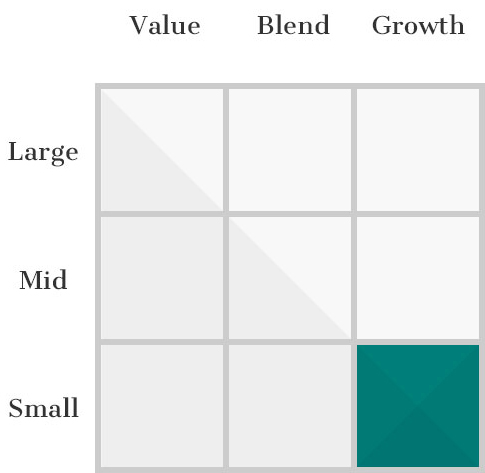Small Cap Growth Fund
Quick Facts
| Investor | Institutional | |
| Ticker: | BUFSX | BUISX |
| Daily Pricing: | ||
| As of 5/15/2025 | ||
| NAV: | $14.00 | $14.10 |
| $ Change: | $0.06 | $0.05 |
| % Change: |
0.43% | 0.36% |
| YTD: |
-5.91% | -5.94% |
| Inception Date: | 4/14/1998 | 7/1/2019 |
| Expense Ratio: | 0.97% | 0.87% |
| Total Net Assets: | $505.72 Million (3/31/25) | |
| Morningstar Category: | Small Cap Growth | |
| Benchmark Index: | Russell 2000 Growth | |
|
Related Material: Fund Fact Sheet Q1 2025 PM Commentary Q1 2025 Portfolio Manager Q&A |
||
|
An actively-managed portfolio of smaller-capitalization, rapidly-growing companies that can benefit from positive, long-term trends remains an excellent way to exploit an inefficient market.
Bob Male, Portfolio Manager
Listen to the Portfolio Managers discuss their Investment Philosophy
Morningstar Rating





Overall Morningstar Rating™ of BUFSX based on risk-adjusted returns among 535 Small Growth funds as of 3/31/25.
Investment Style

Fund Objective & Investment Philosophy
The investment objective of the Buffalo Small Cap Growth Fund is long-term growth of capital. The Small Cap Fund normally invests at least 80% of its net assets in equity securities, consisting of common stocks, preferred stocks, convertible preferred stocks, warrants and rights of small capitalization (“small-cap”) companies. The Small Cap Growth Fund defines small-cap companies as those that, at the time of purchase, have market capitalizations within the range of the Russell 2000 Growth Index.
The Fund managers seek to identify companies for the Fund’s portfolio that are expected to experience growth based on the identification of long-term, measurable secular trends, and which, as a result, the managers believe may have potential revenue growth in excess of the gross domestic product growth rate. Companies are screened using in-depth, in-house research to identify those which the managers believe have attractive valuation, strong management, conservative debt, free cash flow, scalable business models, and competitive advantages.
Performance (%)
| As of 4/30/25 | 3 MO | YTD | 1 YR | 3 YR | 5 YR | 10 YR | 15 YR | 20 YR | Since Inception |
|---|---|---|---|---|---|---|---|---|---|
| BUFFALO SMALL CAP GROWTH FUND - Investor | -15.33 | -11.63 | -4.22 | -2.16 | 4.66 | 7.28 | 8.19 | 7.88 | 10.19 |
| BUFFALO SMALL CAP GROWTH FUND - Institutional | -15.28 | -11.61 | -4.19 | -2.07 | 4.79 | 7.35 | 8.24 | 7.92 | 4.69 |
| Russell 2000 Growth Index | -14.39 | -11.68 | 2.42 | 5.05 | 7.60 | 6.39 | 9.17 | 8.38 | 5.87 |
| Lipper Small Cap Growth Fund Index | -13.48 | -10.00 | 1.59 | 4.05 | 9.19 | 8.21 | 9.90 | 8.57 | 7.01 |
| As of 3/31/25 | 3 MO | YTD | 1 YR | 3 YR | 5 YR | 10 YR | 15 YR | 20 YR | Since Inception |
|---|---|---|---|---|---|---|---|---|---|
| BUFFALO SMALL CAP GROWTH FUND - Investor | -9.88 | -9.88 | -8.96 | -5.93 | 8.83 | 7.26 | 8.49 | 7.78 | 10.30 |
| BUFFALO SMALL CAP GROWTH FUND - Institutional | -9.87 | -9.87 | -8.96 | -5.85 | 8.96 | 7.40 | 8.64 | 7.93 | 10.46 |
| Russell 2000 Growth Index | -11.12 | -11.12 | -4.86 | 0.78 | 10.78 | 6.14 | 9.51 | 8.06 | 5.92 |
| Lipper Small Cap Growth Fund Index | -9.52 | -9.52 | -4.60 | 0.50 | 12.49 | 8.02 | 10.22 | 8.29 | 7.05 |
| Year | 2013 | 2014 | 2015 | 2016 | 2017 | 2018 | 2019 | 2020 | 2021 | 2022 | 2023 | 2024 |
|---|---|---|---|---|---|---|---|---|---|---|---|---|
| BUFFALO SMALL CAP GROWTH FUND - Investor | 44.15 | -6.55 | -4.46 | 6.22 | 27.07 | -5.78 | 40.97 | 66.36 | 4.85 | -30.01 | 5.45 | 5.38 |
| BUFFALO SMALL CAP GROWTH FUND - Institutional | 44.36 | -6.41 | -4.32 | 6.37 | 27.26 | -5.64 | 41.17 | 66.60 | 4.97 | -29.88 | 5.57 | 5.41 |
| Russell 2000 Growth Index | 43.30 | 5.60 | -1.38 | 11.32 | 22.17 | -9.31 | 28.48 | 34.63 | 2.83 | -26.36 | 18.66 | 15.15 |
3 Year Risk Metrics
| BUFSX vs Russell 2000 Growth Index (As of 3/31/24) | |
|---|---|
| Upside Capture | 75.76 |
| Downside Capture | 102.11 |
| Alpha | -6.64 |
| Beta | 0.94 |
| Sharpe Ratio | -0.46 |
Hypothetical Growth of $10,000
This chart illustrates the performance of a hypothetical $10,000 investment made in the Fund on the Inception Date. Assumes reinvestment of dividends and capital gains. This chart does not imply future performance.
Portfolio
Portfolio Characteristics
| (As of 3/31/25) | |
|---|---|
| # of Holdings | 69 |
| Median Market Cap | $4.36 B |
| Weighted Average Market Cap | $4.88 B |
| 3-Yr Annualized Turnover Ratio | 31.22% |
| % of Holdings with Free Cash Flow | 83.58% |
| Active Share | 89.96% |
Top 10 Holdings
| Name of Holding | Ticker | Sector | % of Net Assets |
|---|---|---|---|
| Shift4 Payments, Inc. | FOUR | Financials | 3.21 |
| Summit Materials, Inc. | SUM | Materials | 3.10 |
| Vertex, Inc. | VERX | Information Technology | 2.83 |
| Chart Industries, Inc. | GTLS | Industrials | 2.48 |
| Ligand Pharmaceuticals, Inc. | LGND | Health Care | 2.44 |
| Hamilton Lane, Inc. | HLNE | Financials | 2.42 |
| Palomar Holdings, Inc. | PLMR | Financials | 2.31 |
| Champion Homes, Inc. | SKY | Consumer Discretionary | 2.30 |
| John Bean Technologies Corporation | JBTM | Industrials | 2.17 |
| ICF International, Inc. | ICFI | Industrials | 1.99 |
| TOP 10 HOLDINGS TOTAL | 25.24% | ||
Sector Weighting
As of 3/31/25. Security weightings are subject to change and are not recommendations to buy or sell any securities. Sector Allocation may not equal 100% due to rounding.
Market Capitalization
As of 3/31/25. Market Cap percentages may not equal 100% due to rounding.
Management
Commentary
Literature
| Buffalo Small Cap Growth Fund Documents | Last Updated |
|---|---|
| Fact Sheet | 3/31/25 |
| Quarterly Commentary | 3/31/25 |
| Full Fund Holdings | 12/31/24 |
| Prospectus | 7/29/24 |
| Statement of Additional Information | 7/29/24 |
| Annual Report | 3/31/24 |
| Semi-Annual Report | 9/30/23 |
| Tax Guide - 2023 | 1/8/24 |
Fundamental Approach
We get to know the companies we invest in and learn how they run their business.
Top-Down & Bottom-Up
We identify Top-Down broad, secular growth trends and search for companies from the Bottom-Up.
Proprietary Philosophy
We construct our portfolios based on our own proprietary investment strategy.
Disciplined Investing
Sticking to our disciplined investment strategy ensures we maintain a consistent, balanced approach.
The Morningstar Rating™ for funds, or "star rating", is calculated for managed products (including mutual funds, variable annuity and variable life subaccounts, exchange-traded funds, closed-end funds, and separate accounts) with at least a three-year history. Exchange-traded funds and open-ended mutual funds are considered a single population for comparative purposes. It is calculated based on a Morningstar Risk-Adjusted Return measure that accounts for variation in a managed product's monthly excess performance, placing more emphasis on downward variations and rewarding consistent performance. The top 10% of products in each product category receive 5 stars, the next 22.5% receive 4 stars, the next 35% receive 3 stars, the next 22.5% receive 2 stars, and the bottom 10% receive 1 star. The Overall Morningstar Rating™ for a managed product is derived from a weighted average of the performance figures associated with its three-, five-, and 10-year (if applicable) Morningstar Rating™ metrics. The weights are: 100% three-year rating for 36-59 months of total returns, 60% five-year rating/40% three-year rating for 60-119 months of total returns, and 50% 10-year rating/30% five-year rating/20% three-year rating for 120 or more months of total returns. While the 10-year overall star rating formula seems to give the most weight to the 10-year period, the most recent three-year period actually has the greatest impact because it is included in all three rating periods.
The Buffalo Small Cap Growth Fund (BUFSX) received 2 stars among 535 for the 3-year, 2 stars among 520 for the 5-year, and 3 stars among 395 Small Growth funds for the 10-year period ending 3/31/25, based on risk-adjusted returns.
Diversification does not assure a profit, nor does it protect against a loss in a declining market.
Active investing has higher management fees because of the manager’s increased level of involvement while passive investing has lower management and operating fees. Investing in both actively and passively managed mutual funds involves risk and principal loss is possible. Both actively and passively managed mutual funds generally have daily liquidity. There are no guarantees regarding the performance of actively and passively managed mutual funds. Actively managed mutual funds may have higher portfolio turnover than passively managed funds. Excessive turnover can limit returns and can incur capital gains.


